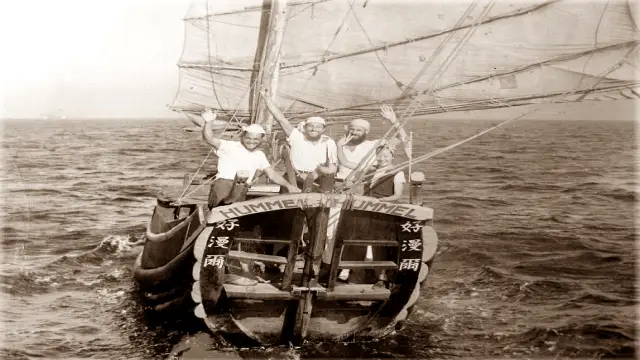In the years leading up to World War II, Shanghai became a city on the brink of collapse. As Japanese forces advanced, foreign residents scrambled to flee the growing chaos. One such escape, led by Dr. E. Allen Petersen and his wife Tani, offers a gripping story of survival that’s largely been lost to time. This true account captures the desperation, bravery, and determination of a few souls who dared to flee one of the world’s deadliest conflicts.
The Fall of Shanghai: A City Under Siege
In 1938, Shanghai was no longer a safe haven. Japanese forces had begun their ruthless invasion, leaving destruction in their wake. Bombings, artillery fire, and street battles raged across the city. For foreign nationals, including Americans and Russians, the only viable escape was by sea.
The brutal atrocities of the Japanese military were well-known by this time, especially after the Rape of Nanking in December 1937. Thousands of women were assaulted, and many civilians were massacred. The violence and chaos were enough to drive anyone to seek a way out, no matter the cost.
A Desperate Search for an Escape Route
Dr. Petersen, an osteopathic surgeon, and his Japanese-American wife, Tani, were among those desperately trying to escape. Ships had already left for safer destinations like Manila and Yokohama. The few remaining vessels were overcrowded or only offered short trips to Hong Kong, which was not far enough for safety.
The couple’s last hope lay in the small, colorful junk they discovered on the French Bund. The 36-foot vessel, Hummel Hummel, would become their means of escape. Despite its modest size, Petersen saw potential in the junk, and after some hard bargaining, he purchased it for $250.
Preparing for a Perilous Voyage
With little time left, the Petersens worked quickly to prepare for their journey. They bought essential supplies, including a sextant, a compass, food, and even a revolver to defend against potential pirate attacks. In addition to these preparations, they also took on two unexpected crew members—Nick and Vic, White Russians fleeing the violence of their homeland.
These two men, who had nothing left in Russia or China, offered their labor in exchange for passage. They didn’t ask for wages; all they wanted was a chance at a new life in the United States. Dr. Petersen hesitated, concerned about their ability to enter the U.S., but eventually, he agreed.
Facing the High Seas
As the Petersens and their new crew set sail, they quickly discovered how dangerous open-sea sailing could be. For days, they battled violent storms, crashing waves, and strong winds. Petersen described how they had to tie themselves to the junk to avoid being swept overboard.
The crew learned quickly, fighting to keep the ship upright in brutal conditions. At times, they feared the vessel would capsize as they struggled to secure the sails. Yet, despite the many challenges, they pushed forward, guided only by the hope of reaching safety.
Yokohama: A Needed Respite
After surviving weeks of storms, Hummel Hummel reached Yokohama, Japan. Although they feared encountering hostility from Japanese civilians, they had little choice but to stop for repairs and supplies. Fortunately, they found some support, though their relief was short-lived. The authorities grew suspicious, suspecting Dr. Petersen and his crew of being spies.
Weeks of interrogation followed. Fortunately, this occurred before tensions between Japan and the United States escalated into full-scale war. Eventually, they were allowed to leave, but the ordeal had left its mark.
The Final Push: Sailing Toward California
On July 12, 1938, Hummel Hummel set sail from Yokohama, embarking on the long journey across the Pacific. The crew faced weeks of rough seas, slow progress, and uncertainty. At one point, they encountered a Swedish ship that gave them their location—they were 700 miles closer to their destination than expected, a huge morale boost for the exhausted crew.
After over two months at sea, they neared the California coast. On their 74th day out, they spotted the American shoreline. A passing ship confirmed their location just north of San Francisco. The realization that their journey was nearly over brought immense relief.
A Hero’s Welcome
When Hummel Hummel sailed into San Pedro harbor in Los Angeles, they were greeted by a flotilla of boats. Reporters and photographers swarmed the junk, eager to capture the moment. Tani’s family was among those welcoming them back, overjoyed to see their loved ones after such a harrowing ordeal.
After 85 days at sea, the crew finally set foot on solid ground. Their journey had been called suicidal by some, but they had made it. Dr. Petersen and Tani had survived against incredible odds, crossing the Pacific on a small Chinese junk.
The Aftermath: What Became of the Crew
While Dr. Petersen and his wife were welcomed back to the U.S., the two White Russians were not as fortunate. Despite their brave efforts, they were denied entry to the United States and returned to Shanghai. However, Petersen ensured they left on a fine ocean liner with money in their pockets, grateful for their help along the way.
Petersen’s story remains a testament to the human will to survive. The courage and determination displayed by all involved in this remarkable journey should not be forgotten.
Conclusion
Dr. Petersen’s voyage on Hummel Hummel offers an extraordinary example of human resilience in the face of danger. His journey, set against the backdrop of a world descending into war, serves as a reminder of how far people will go to seek safety and a better life. While much of history has forgotten this tale, it deserves to be remembered as one of the great survival stories of the 20th century.

